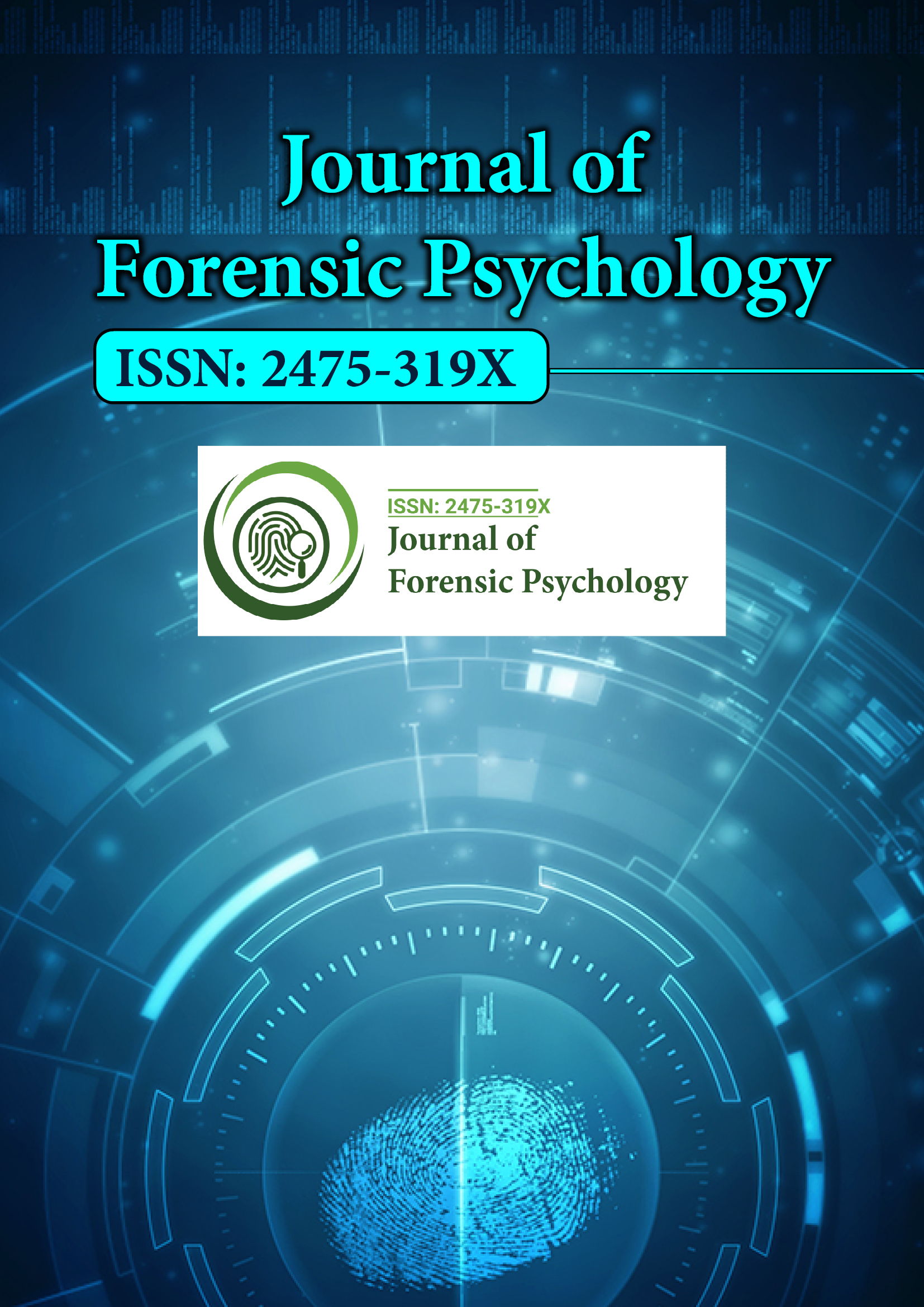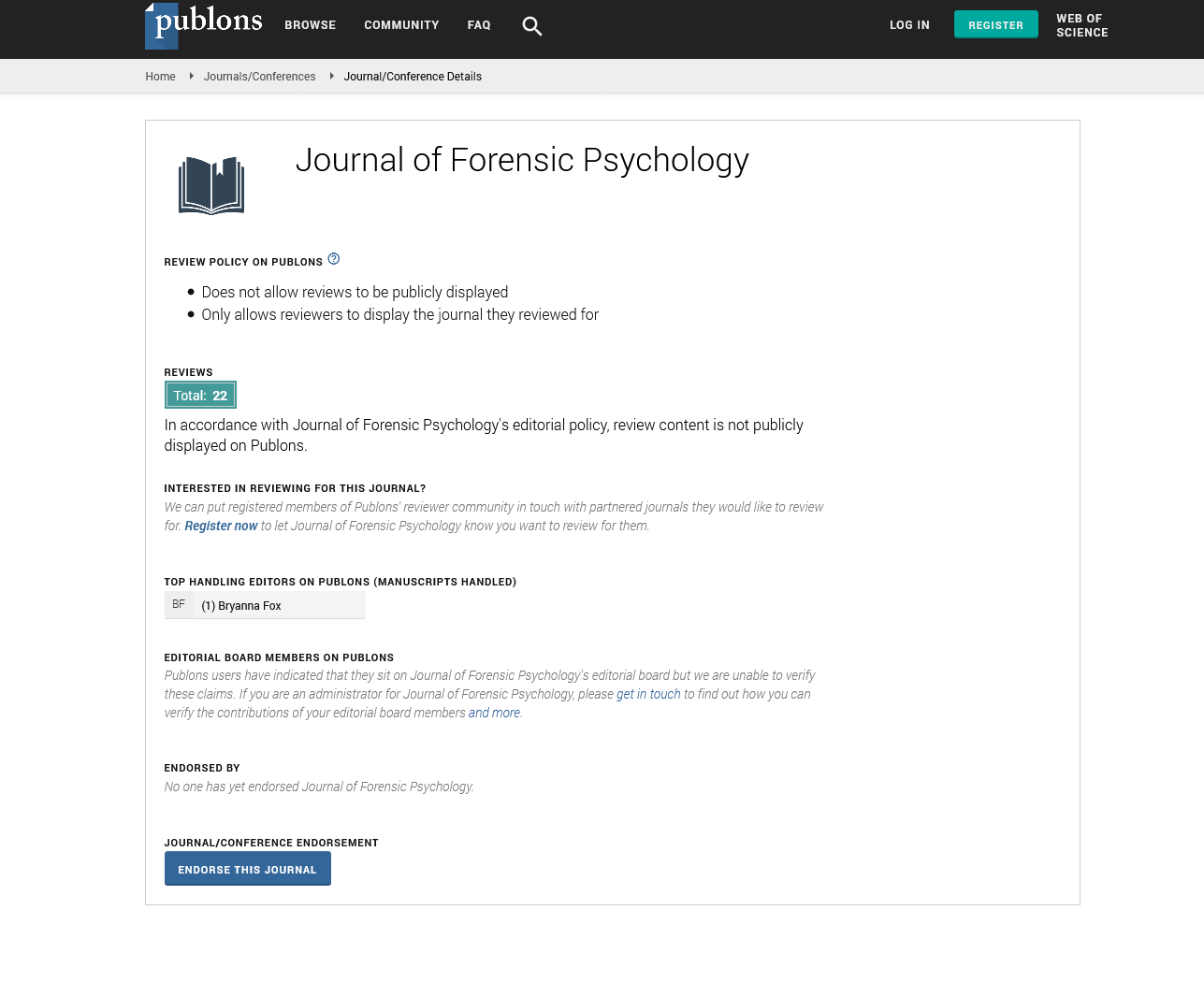Indexed In
- RefSeek
- Hamdard University
- EBSCO A-Z
- Publons
- Geneva Foundation for Medical Education and Research
- Euro Pub
- Google Scholar
Useful Links
Share This Page
Journal Flyer

Open Access Journals
- Agri and Aquaculture
- Biochemistry
- Bioinformatics & Systems Biology
- Business & Management
- Chemistry
- Clinical Sciences
- Engineering
- Food & Nutrition
- General Science
- Genetics & Molecular Biology
- Immunology & Microbiology
- Medical Sciences
- Neuroscience & Psychology
- Nursing & Health Care
- Pharmaceutical Sciences
Perspective - (2022) Volume 7, Issue 11
Scientific Study of Child Sexual Abuse
Elena Bulanovaite*Received: 01-Nov-2022, Manuscript No. JFPY-22-19087; Editor assigned: 03-Nov-2022, Pre QC No. JFPY-22-19087 (PQ); Reviewed: 17-Nov-2022, QC No. JFPY-22-19087; Revised: 24-Nov-2022, Manuscript No. JFPY-22-19087(R); Published: 01-Dec-2022, DOI: 10.35248/2475-319X.22.7.256
Description
The imposition of sexual practices on children is a misuse of the caregiver's authority. Over time, the sequence of events frequently moves from no contact to contact, and the child's trust in the caregiver is abused and deceived.
Pediatricians are in a perfect position to provide the child and family with crucial support because they frequently have dependable relationships with their patients and families. In order to assess and treat sexual abuse, doctors must be aware of the community resources that are accessible, including consultants and referral services.
Signs and symptoms
The interview with the kid is often the most beneficial part of the medical evaluation in cases of Child Sexual Abuse (CSA); the elicited history is frequently the sole diagnostic information that is discovered.
The following are some historical details:
• A general strategy that considers development (ie, ageappropriate)
• First meeting with an emphasis on developing trust (including both child and caregiver)
• Interviewing children and emphasizing the use of straightforward, open-ended, non-leading questions
• Closing and getting ready for the physical examination
The physical examination is conducted generally using the traditional head to toe method. The following are some of the examination's components:
• Identification of the features of importance, including the fossa navicularis, urethral meatus, hymen, labia major and minor, and the mons pubis
• Frog-leg supine posture, knee-chest position, or left lateral decubitus position are the positioning options for best exposure of prepubertal genital tissues.
• Calming the kid while doing the inspection
• Observation and examination of the anogenital region in general, taking note of the child's emotional state and searching for symptoms of injury or infection
• Colposcopy or handheld magnification, when appropriate, to visualize the more recessed genital structures
• Gathering of samples for forensic evidence gathering and Sexually Transmitted Disease (STD) screening
Evaluation of any observable findings - Although most victims of sexual abuse exhibit essentially normal physical results, observable findings may include (1) those caused by acute harm or (2) chronic findings that may represent lingering consequences from recurrent genital contact events.
Prepubertal genital examination results are categorized using the Muram diagnostic categorization method as follows:
• Genitalia in Category I have no discernible abnormalities.
• Category II - Nonspecific findings that have just a weak sex abuse inclination but could potentially be the result of other etiologies
• Strongly suggestive findings with a high possibility of being brought on by sexual abuse fall under category III.
The following 8 types of findings are included in a different classification system created by Adams et al. on the basis of the Muram technique and data from additional components of the sexual abuse assessment.
• Findings in newborns or those frequently observed in children who have not been harmed (ie, normal variants)
• Similar findings brought on by various medical problems
• Findings without a unified expert opinion regarding sexual encounter or trauma (formerly Indeterminate findings)
• Findings that is symptomatic of sexual interaction or trauma
• Residual or recovering wounds
• Injuries caused by piercing trauma from blunt force
• Infection that proves contact with contaminated body secretions through the mucosa (ie, indicating that contact was most likely sexual)
• Evidence of sexual intercourse, such as pregnancy or sperm extracted directly from a child's body
Diagnosis
Cultures are important as forensic evidence because they have historically served as the benchmark for cases of potential sexual abuse. Due to its higher sensitivity, noninvasive sample collection, ability to test for both Neisseria gonorrhoeae and Chlamydia trachomatis with a single sample, and lower cost compared to culture, Nucleic Acid Amplification Testing (NAAT) has been widely used in the sexually active adolescent and adult populations.
• Vaginal or anal discharge Gram stain
• For gonorrhoea, genital, anal, and pharyngeal cultures are used.
• Chlamydia genital and anal culture
• Regarding NAAT, see above (Chlamydia, N. gonorrhea)
Syphilis serology
• Employing Diamond's or InPouch TV media to promote culture (most specific method of diagnosing Trichomonas vaginalis)
• Preparing vaginal discharge with water to check for candida, other microorganisms, and Trichomonas vaginalis.
• Lesion culture for the herpes virus
• For testing for HIV (based on suspected risk)
The following tests may also be taken into account:
• Rape kit forensic evidence gathering
• Toxicology test of the urine
Management
Any conditions found will guide the medical care for CSA. Among the recommendations are the following:
• Prescribe the right drugs to treat STDs.
• A pregnancy in postmenopausal children should be taken into account.
• Recognize that you need emotional support and care the most.
• Make careful to notify the proper Child Protective Services (CPS) organisation when sexual abuse is gravely suspected or has been identified.
• Depending on the perceived risk to the child, consider reporting any suspected sexual abuse.
• Maintain thorough medical records because the health care professional cannot rely exclusively on recollection during lengthy legal proceedings.
• To assess and treat acute stress reaction and, later, Posttraumatic Stress Disorder, mental health counselling is necessary (PTSD).
Citation: Bulanovaite E (2022) Scientific Study of Child Sexual Abuse . J Foren Psy. 7:256.
Copyright: © 2022 Bulanovaite E. This is an open-access article distributed under the terms of the Creative Commons Attribution License, which permits unrestricted use, distribution, and reproduction in any medium, provided the original author and source are credited.

